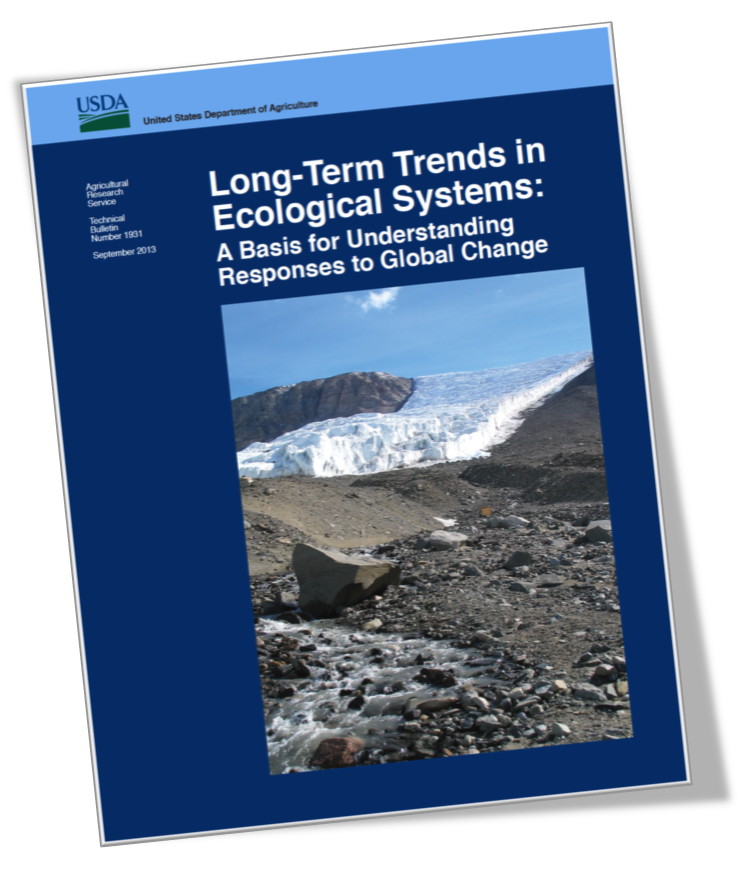The EcoTrends Editorial Committee sorted through vast amounts of historical and ongoing data from 50 long-term research sites in the United States and Antarctica to present in a logical format the variables commonly collected. This work provides cross-site comparisons of ecological responses to global change drivers, as well as long-term trends in global change drivers and responses at site and continental scales.

- This book is available for download (PDF format) below
- Also available here, or by searching at https://www.ars.usda.gov/research/publications/find-a-publication
- While supplies last, single copies of this publication can be obtained at no cost from Debra Peters, USDA-ARS Jornada Experimental Range, P.O. Box 30003, MSC 3JER, NMSU, Las Cruces, NM 88003 or by email at debpeter@nmsu.edu
- Copies may be purchased in various formats (microfiche, photocopy, CD, print on demand) from the National Technical Information Service, 5285 Port Royal Road, Springfield, VA 22161, 800-553-6847, www.ntis.gov
Download the entire book:
Long-Term Trends in Ecological Systems: A Basis for Understanding Responses to Global Change (download PDF – 313 MB)
Download the book by section (PDF)
Introduction to Cross-Site Comparisons and History and Organization of the EcoTrends Project (8.29 MB)
- Chapter 1: Long-Term Trends in Ecological Systems: An Introduction to Cross-Site Comparisons and Relevance to Global Change Studies
- Chapter 2: History and Organization of the EcoTrends Project
Cross-Site Comparisons of Ecological Responses to Global Change Drivers (21.8 MB)
- Chapter 3: Cross-Site Comparisons of Ecological Responses to Climate and Climate-Related Drivers
- Chapter 4: Cross-Site Comparisons of State-Change Dynamics
- Chapter 5: Patterns of Net Primary Production Across Sites
- Chapter 6: Cross-Site Comparisons of Precipitation and Surface Water Chemistry
- Chapter 7: Cross-Site Comparisons of Ecological Responses to Long-Term Nitrogen Fertilization
- Chapter 8: Long-Term Trends in Human Population Growth and Economy Across Sites
- Chapter 9: Disturbance Regimes and Ecological Responses Across Sites
- Chapter 10: Cross-Site Studies “By Design”: Experiments and Observations That Provide New Insights
Long-Term Trends in Global Change Drivers and Responses at Site and Continental Scales (197 MB)
- Chapter 11: Long-Term Trends in Climate and Climate-Related Drivers
- Chapter 12: Long-Term Trends in Precipitation and Surface Water Chemistry
- Chapter 13: Long-Term Trends in Human Demography and Economy Across Sites
- Chapter 14: Long-Term Trends in Production, Abundance, and Richness of Plants and Animals
- Chapter 15: Management and Policy Implications of Cross- and Within-Site Long-Term Studies
- Chapter 16: Recommendations for Data Accessibility
- Chapter 17: Long-Term Research Across Sites, Ecosystems, and Disciplines: Synthesis and Research Needs
Appendices & Index (79 MB)
- Appendix 1: Site Descriptions
- Appendix 2: Average (Standard Error) Maximum, Mean, and Minimum Air Temperature and Annual Precipitation at Each Site
- Appendix 3: Average (Standard Error) Ice Duration, Sea Level, Streamflow, Water Clarity, and Water Temperature for Sites With Data
- Appendix 4: Regression Coefficients and R2 Values for Nine Climatic Variables for Which Linear Regression Against Time Is Significant (p < 0.05)
- Appendix 5: Annual Average (Standard Error) Nitrogen (as Nitrate) From Various Sources at Sites With Data
- Appendix 6: Regression Coefficients and R2 Values for Nitrogen (as Nitrate) From Various Sources for Which Linear Regression Against Time Is Significant (p < 0.05)
- Appendix 7: Annual Average (Standard Error) Nitrogen (as Ammonium) From Various Sources at Sites With Data
- Appendix 8: Regression Coefficients and R2 Values for Nitrogen (as Ammonium) From Various Sources for Which Linear Regression Against Time Is Significant (p < 0.05)
- Appendix 9: Annual Average (Standard Error) Sulfur (as Sulfate) From Various Sources at Sites With Data
- Appendix 10: Regression Coefficients and R2 Values for Sulfur (Sulfate) From Various Sources for Which Linear Regression Against Time Is Significant (p < 0.05)
- Appendix 11: Annual Average (Standard Error) Chloride From Various Sources at Sites With Data
- Appendix 12: Regression Coefficients and R2 Values for Chloride From Various Sources for Which Linear Regression Against Time Is Significant (p < 0.05)
- Appendix 13: Annual Average (Standard Error) Calcium From Various Sources at Sites With Data
- Appendix 14: Regression Coefficients and R2 Values for Calcium From Various Sources for Which Linear Regression Against Time Is Significant (p < 0.05)
- Appendix 15: Human Population and Economy Variables in 2000 for the Focal County of Each Site, as Grouped by Ecosystem Type
- Appendix 16: Annual Average (Standard Error) Aboveground Net Primary Production (ANPP) at Sites With Data
- Appendix 17: Other Measures of Average (Standard Error) Terrestrial Production at Sites With Data
- Appendix 18: Average (Standard Error) Aquatic Production at Sites With Data
- Appendix 19: Average (Standard Error) Biomass of Primary Producers (Plants, Algae) for Sites With Data
- Appendix 20: Average (Standard Error) Plant Species Richness for Sites With Data
- Appendix 21: Average (Standard Error) Animal Abundance for Sites With Data
- Appendix 22: Average (Standard Error) Animal Species Richness for Sites With Data
- Appendix 23: Regression Coefficients and R2 Values for Plant and Animal Variables for Which Linear Regression of Each Variable Against Time Is Significant (p < 0.05) and the Trend Appears Linear
- Appendix 24: Lead Principal Investigator(s) (PI), Information Managers (IM), and Administrative Program of the LTER Programs
- Appendix 25: Researchers Involved in the EcoTrends Project at Non-LTER Sites
- Appendix 26: List of Stations and Length of Record for Each Climate Variable by Site
- Appendix 27: List of Stations and Length of Record for Each Precipitation or Surface Water Chemistry Variable by Site
- Appendix 28: List of Stations and Length of Record for Each Plant and Animal Variable by Site, as Grouped by Ecosystem Type